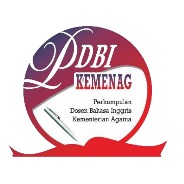The Effect of Reading Newspaper and Short Stories on Students’ Vocabulary Size at Cenderawasih University Setting
Abstract
This study aimed to investigating the effect of reading newspapers and short stories on students' vocabulary size and whether there is a significant difference between students who read newspapers and short stories at third semester of English Education Study Program in Cenderawasih University. The method of the research was quasi-experimental. The sample of the research was the students of third semester English Education Study Program at Cenderawasih University. It consisted of 36 students who were divided into two groups, i.e., Newspaper group and Short Story group, which were given the texts as a treatment based on their name's group. The test -2,000-VLT design of Nation- was used as the primary instrument test to measure the students' vocabulary size before and after given treatment. After analyzing the data, both groups demonstrated a significant increase in vocabulary size. The Newspapers group increased from 1,206 to 1,556 words, while the Short Story group shows the mean 1,134 words moved up to 1,469 words. However, the T-test shows that the vocabulary size of both the Newspaper group and Short Story group is not different significantly.
Keywords: Effect, Vocabulary Size, Reading, Newspaper, Short Story
Keywords
Full Text:
PDFReferences
Al Farsi, B. (2008). Morphological awareness and its relationship to vocabulary knowledge and morphological complexity among Omani EFL University students. Unpublished Master’s Thesis, University of Queensland, St Lucia, Australia.
Cameron, L. (2001). Teaching languages to young learners. Cambridge: Cambridge University Press.
Chung, Mihwa. (2009). The Newspaper Word List: A Specialised Vocabulary for Reading Newspapers. JALT Journal, 31(2), 159-182.
Chung, Mihwa., & Nation. (2003). Technical vocabulary in specialized text. Reading in a Foreign Language, 15(2), 103-116.
Danisman. (2007). Using Newspaper to Teach Vocabulary to Pre-Intermediate Level Preparatory Class Students. Unpublished Thesis. Konya: Selcuk University.
Decarrico, S Jeanette. (2001). Teaching English as a Second of Foreign Language (Third Edition). New York : Heinle & Heinle.
Elliot, Ellen Mary. (2007). Implementing the Rich and Intensive Method of Vocabulary Instruction for English Language Learner. Minnesota: Hamline University.
Ellis, Rod. (2010). Second Language Acquisition, teacher education and language pedagogy. Language teaching,43(2), 182-201.
Erkaya, Rocha O. (2010). Benefits of using short stories in the EFL context. Asian EFL Journal. 1-13.
Gass, S.M. (2013). Second language acquisition: an introductory course. New York & London: Routledge.
Grabe, W. And Stoller, F.L. (2002). Teaching and researching reading.
Harlow: Pearson Education.
Jackson, Y. (2015). The pedagogy of confidence: Inspiring high intellectual performance in urban schools. Teachers College Press.
Kweldju, S. (2004). Lexically-based Language Teaching: An Innovative Step for ELT in Indonesia. In Cahyono, B. Y. & Widiati, U. (Eds.), The Tapestry of English Language Teaching and Learning in Indonesia (pp. 37-56). Malang: State University of Malang Press.
Mehisto, P. (2012). Criteria for Producing CLIL Learning Material. Online Submission
Morin, R. (2003). Derivational morphology analysis as a strategy for vocabulary acquisition in Spanish. The Modern Language Journal, 87, 200-221.
Nation, I.S.P. (2001). Learning Vocabulary in Another Language. Cambridge: Cambridge University Press.
Parvareshbar, Fatemeh., & Ghoorchaei, Behrooz. (2016). The Effect of Using Short Stories on Vocabulary Leraning of Iranian EFL Learners. Theory and Practice in Language Studies, 6(7), 1476-1483.
Ponniah, R.J. (2011). Incidental Acquisition of Vocabulary by Reading. National Institute of Technology in India, 11(2), 135-139.
Sahib, R. Bin. (2019). The Use of Translanguaging as a Pedagogical Strategy In Efl Classroom A Case Study At Bulukumba Regency. LET: Linguistics, Literature and Language Teaching Journal, 9(2), 22–48.
Sahib, R. Bin. (2019). Translanguaging as a Pedagogical Strategy in EFL Classroom. ELT LECTURA, 5(2), 1–7.
Schmitt, Norbert., & Mc Micael Carthey.(1997). Vocabulary in language Teaching. New York: Cambridge University Press.
Thornbury, Scoot. (2002). How to Teach Vocabulary. Malaysia: Pearson.
Ur, Denny. (1996). A Course in Language Teaching. Cambridge: Cambridge University Press.
Waring, Rob & Nation, Paul. (2004). Second Language Learning and Incidental Vocabulary Learning. Angles on the English- Speaking World, 4, 11- 22.
Webb, S., Newton, J., & Chang, A. (2013) Incidental learning of collocation. Language Learning, 63(1), 91-120.
Webb, S. (2007). The effects of repetition on vocabulary knowledge. Applied linguistics, 28(1), 46-65.
Yakhabi, Masumeh. (2011). The Relationship between Morphological Awareness and Vocabulary Size of EFL Learners. English Language Journal, 4(.4), 262-273.
DOI: http://dx.doi.org/10.29240/ef.v4i1.1158
Refbacks
- There are currently no refbacks.
Copyright (c) 2020 Erfin Wijayanti

This work is licensed under a Creative Commons Attribution-NonCommercial-ShareAlike 4.0 International License.
INDEXED BY:
 This work is licensed under a Creative Commons Attribution-NonCommercial-ShareAlike 4.0 International License
This work is licensed under a Creative Commons Attribution-NonCommercial-ShareAlike 4.0 International License
@ ENGLISH FRANCA : Academic Journal of English Language and Education
Jl. Dr. AK Gani No 1 Dusun Curup, Rejang Lebong Regency, Bengkulu Province, Indonesia, 39119.
Dr. Eka Apriani, M.Pd., email: efranca@iaincurup.ac.id, eka.apriani@iaincurup.ac.id.




.png)












